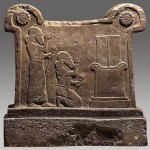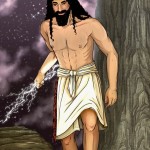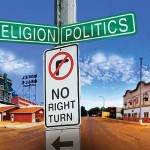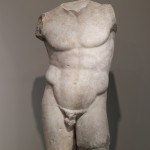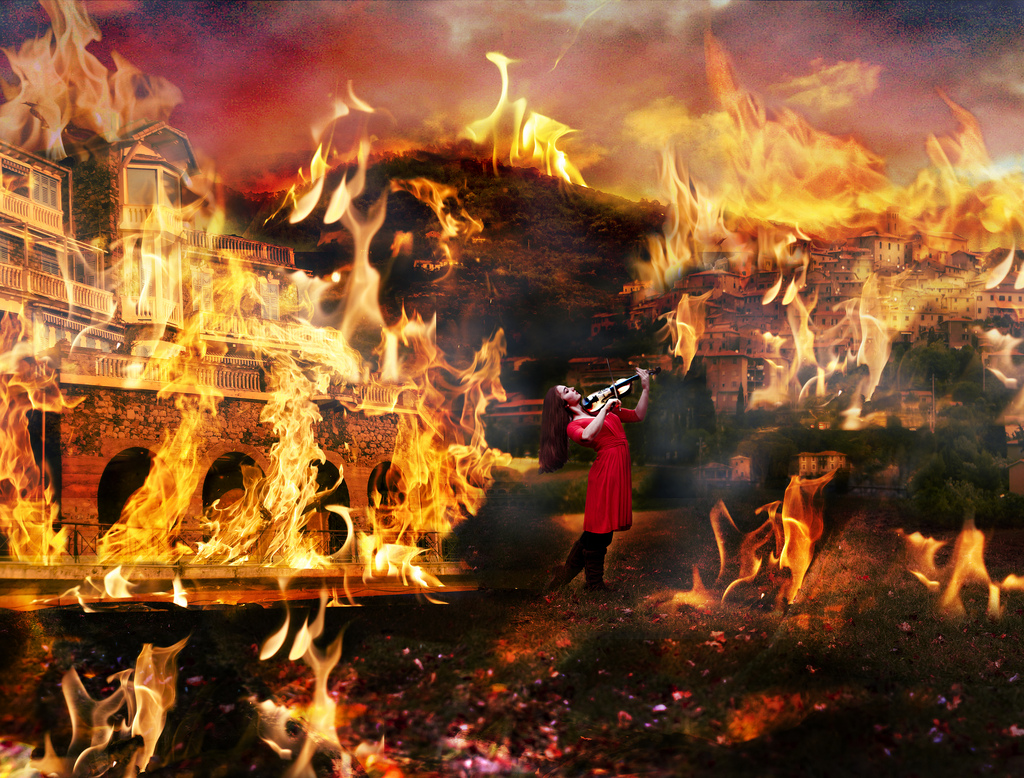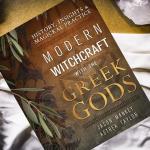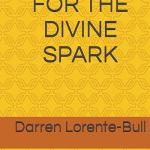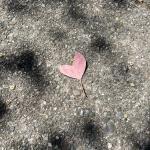Tess Dawson has accused me of “defacing sacred images for fun and profit.” That’s a serious charge. And it deserves a serious response.
First of all, let me say I am disturbed by Tess’ unwillingness to address me directly. This has been a pattern of hers (and of some other polytheists), writing about me without naming me or linking to my blogs. I suppose I understand not wanting to direct traffic to someone’s blog that you fundamentally disagree, although I make it a practice to provide links to my rhetorical opponents. But Tess has attacked my writing frequently enough — here and here and here — without offering me the opportunity to respond. And never once has she reached out to me personally. To my mind, this smacks of cowardice.
Tess’ issue with me this time has to do with the image that is the header of this blog (above), which is taken from the Egyptian Stele of Qetesh (below). First, it’s worth pointing out that about half dozen blogs here at Patheos Pagan employ images borrowed from ancient paganism. And I suspect that a lot of Pagan blogs hosted elsewhere employ similar images. Apparently, Tess has singled my header out for two reasons. The first (unstated) is that it intersects with Canaanite myth, with is Tess’s specific area of interest, as she is a Canaanite deconstructionist. The second (stated) is that I altered the image more than the other bloggers have.
First, Tess goes into a lengthy analysis of the meaning of the original image. If you’re interested in Egyptian or Canaanite iconography, I encourage you to read it. As Tess says, the image “holds many layers of meaning, many depths, many mysteries and Mysteries.” And, in point of fact, that is why I love the image, why it is holy to me (also), and why I chose it for the header of my blog. The image depicts three deities: Min, an Egyptian ithyphallic fertility god, Qudshu, an Egyptian goddess of sexuality and war, and Resheph, a Canaanite god of the desert. The figures are structured in such a way that the goddess functions as a “fulcrum” between the two opposing gods — representing life and death. To the gods the goddess offers symbols of life and death and rebirth. (The image was likely arose out of the historical interaction of Egyptian and Canaanite cultures.)
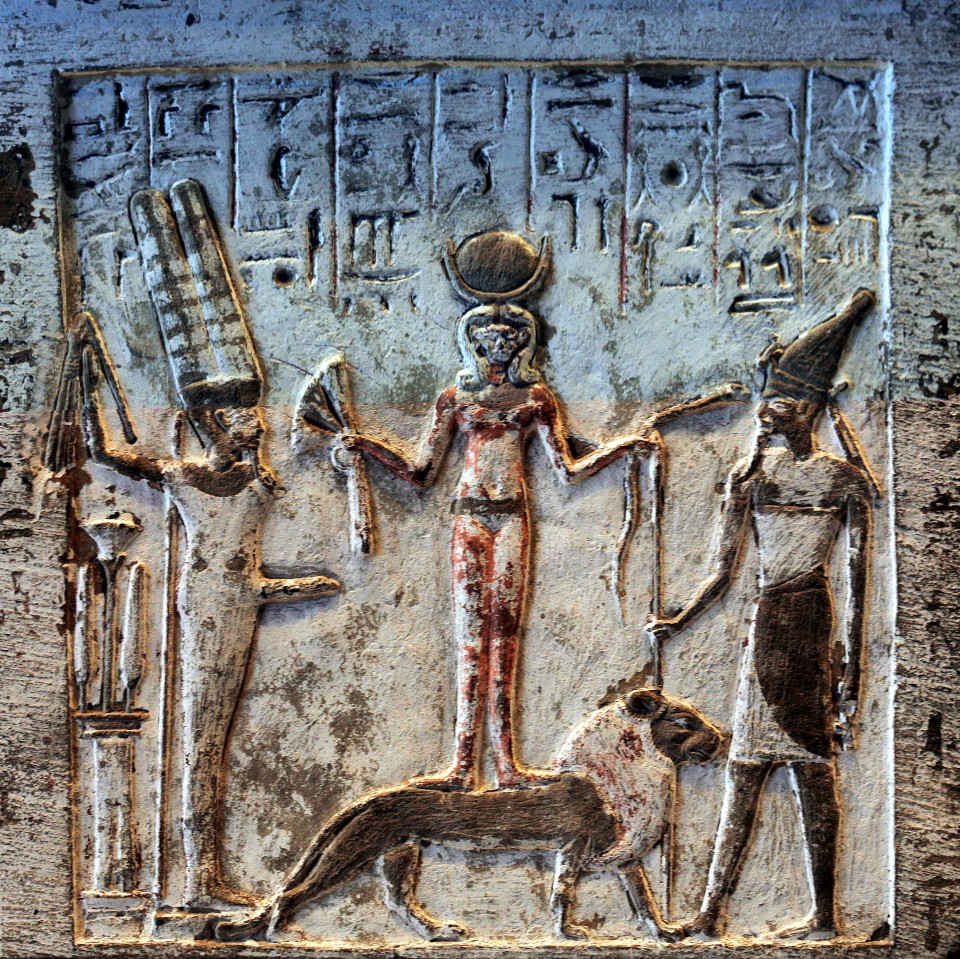
I agree with Tess that it is an image which is deeply sacred and meaningful, and like her, I hold it in reverence. In fact, it is one of three images that I have hanging above my altar. It has been there as long as my altar has. But where I differ from Tess is that I do not believe the “image if altered suffers a loss of meaning, of depth, of symbolism.” You see, Tess is a reconstructionsist. And so, for her, this icon has one meaning which was literally set in stone thousands of years ago. The holy image, says Tess, “does not function the same when it is altered and it would not carry the same message”. Well, that’s true. But since I’m not a reconstructionist, that doesn’t bother me as much as it does Tess. I can’t imagine how any image could carry the same message to me as it did to an Egyptian three thousand years ago. But, again, that’s why I’m not a reconstructionist.
That’s not to say I am wholly dismissive of the original intent of the artist. But I reject the suggestion that the meaning of the image cannot evolve with time. We are talking about an Egyptian image, after all! The Egyptians were almost as syncretistic as the Romans. In fact, the goddess Qudshu is herself a syncretistization of multiple goddesses, including Athirat (Asherah), Astarte, and Anat. And I suspect that the Egyptian artist was playing on the theme of another Egyptian holy trinity: Osiris, Isis, and Set, with whom they share much of the same symbolism: Like Min, Osiris is also an ithyphallic fertility deity sometimes shown holding a flail; Isis is often conflated with Hathor who, like Qudshu, is depicted with a headpiece with the sun held between her horns; and like Reseph, Set is also a desert deity. The meaning of this image evolved over time in Egyptian culture, and it continues to evolve in contemporary Pagan culture. I am a tiny part of that evolutionary process.
Tess seems to think I am “making fun” of the Egyptian image. I did think the alteration of the image was clever, but as I explained in my very first post here at Patheos:
“The image expresses a dynamic opposition that is at the heart of both my own personal mythology and my relationship with the world. While the title of this blog is intended to be somewhat humorous, the impact of my allergies on my spirituality over the course of my life has actually quite serious.”
I went on to explain the impact of seasonal allergies on my Pagan practice:
“When you have allergies, you can’t breathe normally. It is easy to take breath for granted, until you don’t have it. When my allergies hit, it feels like I am walking around in a fog. Obviously I can’t smell, which means I can’t taste. That means that my appetite is diminished. Even my sense of touch seems muted somehow. It feels like there is an invisible film over everything. And I avoid human contact. I feel disconnected from everything. If the quintessential Neopagan experience is one of connectedness, then allergies can pose a real difficulty. (It’s no coincidence, I think, that breathing exercises are such an important part of Pagan practice — as well as many other traditions.)”
But it goes deeper than that. And if Tess had bothered to read what I had previously written about the image, she would know that. The irony of being a Pagan with seasonal allergies expresses an essential conflict at the core of my psyche, a conflict between the desire for communion with nature on the one hand and the desire to transcend nature on the other:
“I wonder sometimes if my predisposition to psychological escapism and transcendental religion in my early years was related to my allergies. When life is one big oxygen-deprived fog, it is natural to want to escape into fantasy or long for a transcendent heaven. Gradually though, as I left the Christian religion of my upbringing behind, I came to realize that my only “sin” was not loving life — this life — enough. … I eventually came to see that what I needed was not transcendence, not escape from life, but to experience life more fully, more intensely. … And this is what Paganism does for me.”
The image from the stele captures this sense of being poised between two competing impulses and struggling to reconcile them, like a lover caught between two suitors: immanence and transcendence. My natural inclination is toward transcendence, but Paganism helps me see the holiness in things that our culture tells us are “impure”: dirt, insects, menstrual blood, and … yes, Tess, mucus!
Now Tess has a point about the commercialization and trivialization of images of deities in our culture. I’m reminded of a controversial Burger King campaign in India that appropriated the image of a Hindu goddess for purely commercial purposes. But that kind of desecration is not what is going on with the header of my blog. This is where I write about my spirituality. This is where I write about holy things. And this image is holy to me — both the original image and the “adulterated” image (as Tess calls it). Now maybe Tess can’t appreciate the connections I’ve drawn above. I don’t expect her to. But I do expect her to respect the fact that the connection exists for me. It is as real and as holy to me as her relationship to her gods is to her.
It is unfortunate that Tess finds the alteration disrespectful, but the truth is that she finds everything about my spirituality disrespectful. Because I am an eclectic Neo-Pagan and she is a reconstructionist. We will never agree, any more than a progressive Episcopalian and a fundamentalist Baptist will agree.
Tess goes so far as to say that, by altering the image, I have “taken these individual, real, living, viable, thinking, feeling, cognizant beings, and sets to erase them of their strength, depth, agency, and majesty … [and pulled] them into a pale, shallow, private world of impotent shadows of human thought.” Wow! I guess I didn’t know my own strength. I single-handedly transformed real living gods into impotent shadows. Seriously, though, Tess can’t have it both ways. If the gods are real, living beings with strength and majesty, then nothing I do will diminish them. And if I can diminish them, then they weren’t real, living beings to begin with.
Now, what I can do is diminish them in other people’s eyes. And this must be what has happened for Tess. For her, the unaltered image is holy, and my alteration of it ruins it for her. I get that. But my response is: So don’t look at it. “Every time I go over to that blog,” she write, “I am faced with the very glaring insult to my deities.” Honestly, why does she keep coming over to my blog then? Especially when she says that I have nothing of value to say about the gods?

Tess claims that the alteration is not harmless because it “robs” the image of its meaning. Now, if I had actually altered the original image (as many ancient Egyptian pharaohs did), then I would agree with her. But, come on! I altered a digital copy of the image. There are thousands upon thousands of other unaltered digital copies of the image and the original image survives un-“adulterated”. So nothing has been “robbed”.
Tess even goes so far as to compare the header on my blog to the desecration of sacred images in the Middle East by extremist militant groups! And here I have to take umbrage. Because the desecration of holy places and the destruction of museum artifacts is something I find deeply disturbing and tragic. And Tess’ comparison of me to “Daesh” (Isis) makes her no better than those polemicists who compare everyone who disagrees with them to Nazis. It’s inaccurate and irresponsible. Tess is a writer who I have long respected, because until now she has been able to talk about Neo-Pagans with respect, even while disagreeing with them. But this time, she has failed. And it disturbs me that Tess is bringing this kind of fundamentalism to contemporary Polytheism.


